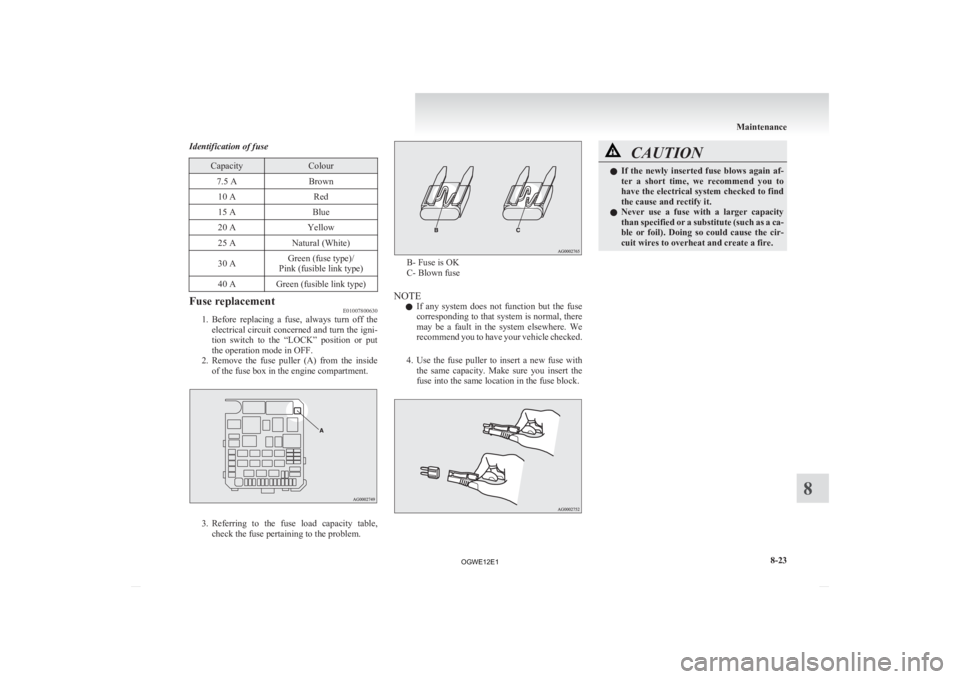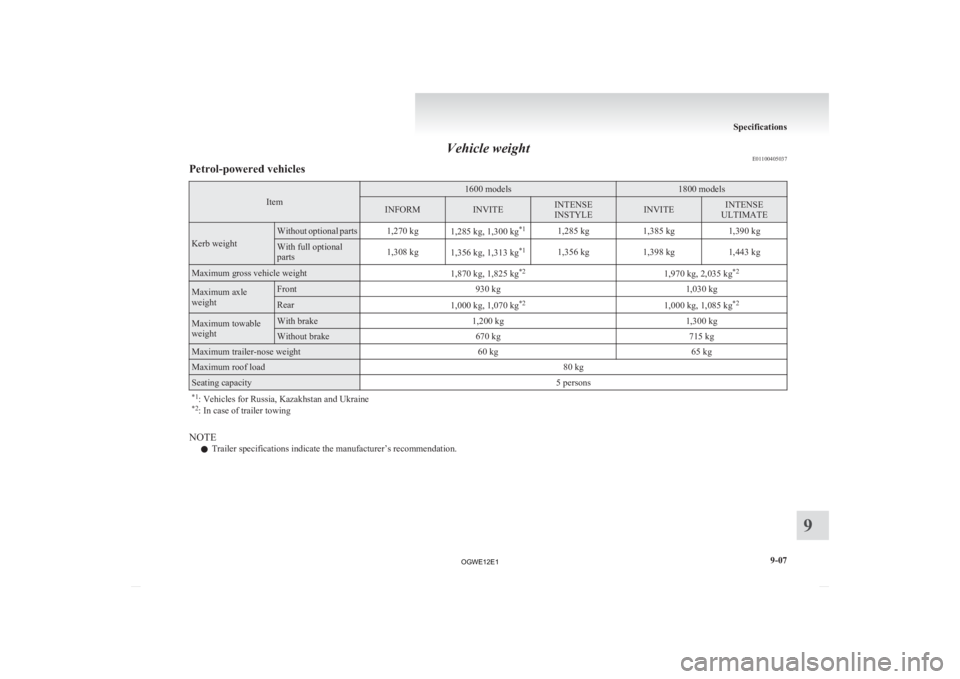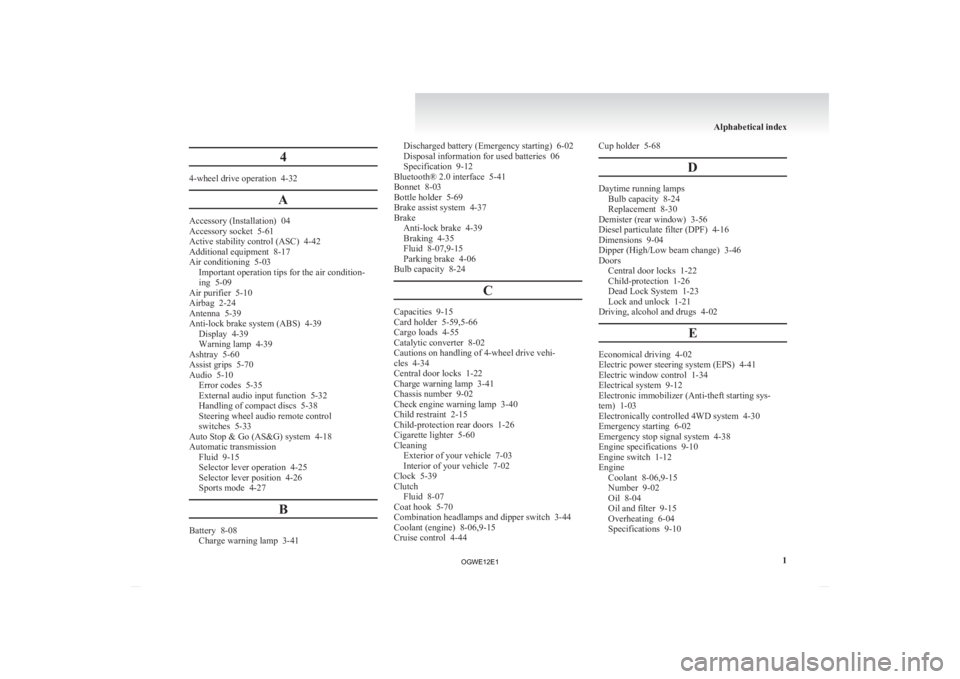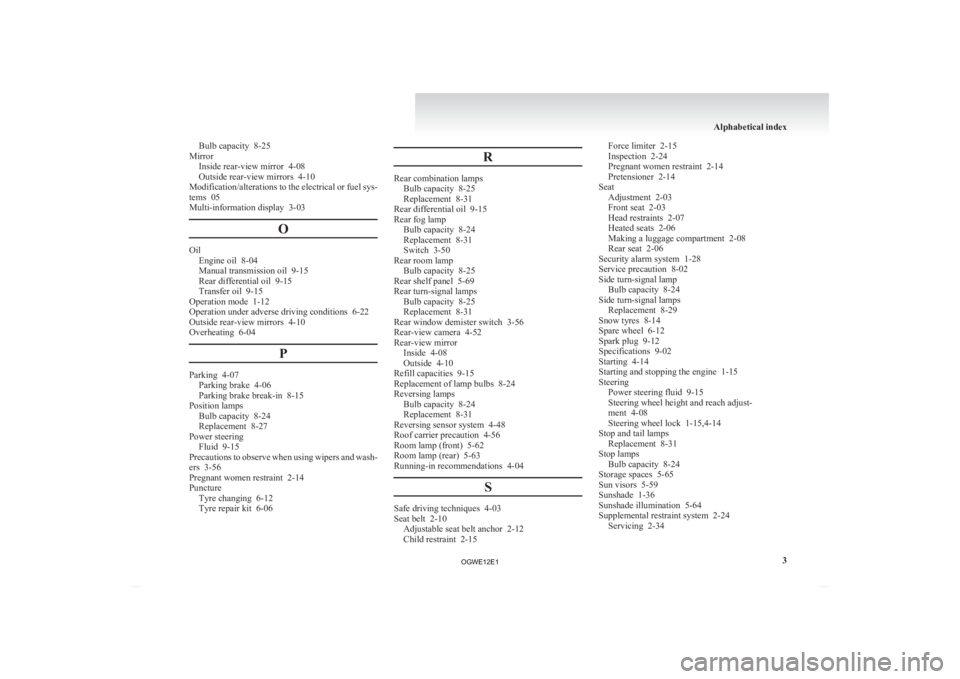ECO mode MITSUBISHI ASX 2012 Owner's Manual (in English)
[x] Cancel search | Manufacturer: MITSUBISHI, Model Year: 2012, Model line: ASX, Model: MITSUBISHI ASX 2012Pages: 378, PDF Size: 18.2 MB
Page 320 of 378

We recommend you to have the battery checked be-
fore
the start of cold weather and, if necessary,
have it charged or replaced.
This does not only ensure reliable starting, but a bat-
tery which is kept fully charged also has a longer life.
Disconnection and connection E01011000079
To disconnect the battery cable, stop the engine,
first
disconnect the negative (-) terminal and then
the positive (+) terminal.
When connecting the battery, first connect the posi-
tive (+) terminal and then the negative (-) terminal.
NOTE
l Open the terminal cover (A) before discon-
necting or connecting the positive (+) termi-
nal of the battery.
l Loosen the nut (B), and then disconnect the
battery cable from the positive (+) terminal.
Petrol-powered vehicles
Diesel-powered vehicles WARNING
l Keep
sparks, cigarettes, and flames away
from the battery because the battery
could explode.
l The battery electrolyte is extremely caus-
tic. Do not allow it to come in contact
with your eyes, skin, clothing, or the pain-
ted surfaces of the vehicle.
Spilt electrolyte should be flushed imme-
diately with ample amounts of water.
Irritation to eyes or skin from contact
with electrolyte requires immediate medi-
cal attention.
l Ventilate when charging or using the bat-
tery in an enclosed space. CAUTION
l
Keep it out of reach of children.
l Never
disconnect the battery with the ig-
nition switch or the operation mode in
ON. Doing so could damage electric com-
ponents. CAUTION
l
Never
short-circuit the battery. This
could cause it to overheat and be damaged.
l If the battery is to be quick-charged, first
disconnect the battery cables.
l In order to prevent a short circuit, be
sure to disconnect the negative (-) termi-
nal first.
l Always wear protective eye goggles when
working near the battery.
l Do not bring the nearby parts, the plastic
parts and so on into contact with sulphu-
ric acid (battery electrolyte) which may
crack, stain or discolour them.
If they are in contact, wipe off with soft
cloth, chamois or the like and an aqueous
solution of neutral detergent then imme-
diately rinse the affected parts with plen-
ty of water.
NOTE l Keep
the terminals clean. After the battery is
connected, apply terminal protection grease.
To clean the terminals, use lukewarm water.
l Check to see if the battery is securely instal-
led and cannot be moved during travel. Also
check each terminal for tightness.
l When the vehicle is to be left unused for a
long period of time, remove the battery and
store it in a place where the battery fluid will
not freeze. The battery should be stored only
in a fully charged condition. Maintenance
8-10
8
OGWE12E1
Page 333 of 378

Identification of fuse
Capacity Colour
7.5 A Brown
10 A Red
15 A Blue
20 A Yellow
25 A Natural (White)
30 A Green (fuse type)/
Pink (fusible link type)
40 A Green (fusible link type) Fuse replacement
E01007800630
1. Before replacing a fuse, always turn off the
electrical circuit concerned and turn the igni-
tion switch to the “LOCK” position or put
the operation mode in OFF.
2. Remove the fuse puller (A) from the inside of the fuse box in the engine compartment. 3. Referring
to the fuse load capacity table,
check the fuse pertaining to the problem. B- Fuse is OK
C- Blown fuse
NOTE l If
any system does not function but the fuse
corresponding to that system is normal, there
may be a fault in the system elsewhere. We
recommend you to have your vehicle checked.
4. Use the fuse puller to insert a new fuse with the same capacity. Make sure you insert the
fuse into the same location in the fuse block. CAUTION
l
If
the newly inserted fuse blows again af-
ter a short time, we recommend you to
have the electrical system checked to find
the cause and rectify it.
l Never use a fuse with a larger capacity
than specified or a substitute (such as a ca-
ble or foil). Doing so could cause the cir-
cuit wires to overheat and create a fire. Maintenance
8-23 8
OGWE12E1
Page 351 of 378

Vehicle weight
E01100405037
Petrol-powered vehicles Item 1600 models 1800 models
INFORM INVITE INTENSE
INSTYLE
INVITE INTENSE
ULTIMATE Kerb weight Without optional parts 1,270 kg
1,285 kg, 1,300 kg*1
1,285 kg 1,385 kg1,390 kg With full optional
parts
1,308 kg
1,356 kg, 1,313 kg *1
1,356 kg 1,398 kg1,443 kgMaximum gross vehicle weight
1,870 kg, 1,825 kg*2
1,970 kg, 2,035 kg*2Maximum axle
weight Front
930 kg 1,030 kgRear
1,000 kg, 1,070 kg*2
1,000 kg, 1,085 kg*2Maximum towable
weight With brake
1,200 kg 1,300 kgWithout brake
670 kg 715 kgMaximum trailer-nose weight
60 kg65 kgMaximum roof load
80 kgSeating capacity
5 persons
*1 : Vehicles for Russia, Kazakhstan and Ukraine
*2 : In case of trailer towing NOTE
l Trailer specifications indicate the manufacturer’s recommendation. Specifications
9-07 9
OGWE12E1
Page 352 of 378

Item 2000 models
2WD 4WD
M/T CVT
INVITE INTENSE
ULTIMATE INVITE INTENSE
ULTIMATE INVITE INTENSE
ULTIMATE Kerb weight Without optional
parts
1,355 kg 1,360 kg 1,420 kg 1,425 kg 1,450 kg 1,455 kg With full optional
parts
1,368 kg 1,413 kg 1,433 kg 1,478 kg 1,463 kg 1,508 kgMaximum gross vehicle weight
1,970 kg, 2,035 kg*Maximum axle
weight Front
1,030 kgRear
1,000 kg, 1,085 kg*Maximum towable
weight With brake
1,300 kgWithout brake
715 kg 745 kgMaximum trailer-nose weight
65 kgMaximum roof load
80 kgSeating capacity
5 persons
* : In case of trailer towing NOTE
l Trailer specifications indicate the manufacturer’s recommendation. Specifications
9-08
9
OGWE12E1
Page 363 of 378

4
4-wheel drive operation 4-32
AAccessory (Installation) 04
Accessory socket 5-61
Active stability control (ASC)
4-42
Additional equipment 8-17
Air conditioning 5-03 Important operation tips for the air condition-
ing 5-09
Air purifier 5-10
Airbag 2-24
Antenna 5-39
Anti-lock brake system (ABS) 4-39 Display 4-39
Warning lamp 4-39
Ashtray 5-60
Assist grips 5-70
Audio 5-10 Error codes 5-35
External audio input function 5-32
Handling of compact discs 5-38
Steering wheel audio remote control
switches 5-33
Auto Stop & Go (AS&G) system 4-18
Automatic transmission Fluid 9-15
Selector lever operation 4-25
Selector lever position 4-26
Sports mode 4-27
BBattery 8-08
Charge warning lamp 3-41 Discharged battery (Emergency starting) 6-02
Disposal information for used batteries
06
Specification 9-12
Bluetooth® 2.0 interface 5-41
Bonnet 8-03
Bottle holder 5-69
Brake assist system 4-37
Brake Anti-lock brake 4-39
Braking 4-35
Fluid 8-07,9-15
Parking brake 4-06
Bulb capacity 8-24
C Capacities 9-15
Card holder 5-59,5-66
Cargo loads 4-55
Catalytic converter
8-02
Cautions on handling of 4-wheel drive vehi-
cles 4-34
Central door locks 1-22
Charge warning lamp 3-41
Chassis number 9-02
Check engine warning lamp 3-40
Child restraint 2-15
Child-protection rear doors 1-26
Cigarette lighter 5-60
Cleaning Exterior of your vehicle 7-03
Interior of your vehicle 7-02
Clock 5-39
Clutch Fluid 8-07
Coat hook 5-70
Combination headlamps and dipper switch 3-44
Coolant (engine) 8-06,9-15
Cruise control 4-44 Cup holder 5-68
D Daytime running lamps
Bulb capacity
8-24
Replacement 8-30
Demister (rear window) 3-56
Diesel particulate filter (DPF) 4-16
Dimensions 9-04
Dipper (High/Low beam change) 3-46
Doors Central door locks 1-22
Child-protection 1-26
Dead Lock System 1-23
Lock and unlock 1-21
Driving, alcohol and drugs 4-02
E Economical driving 4-02
Electric power steering system (EPS)
4-41
Electric window control 1-34
Electrical system 9-12
Electronic immobilizer (Anti-theft starting sys-
tem) 1-03
Electronically controlled 4WD system 4-30
Emergency starting 6-02
Emergency stop signal system 4-38
Engine specifications 9-10
Engine switch 1-12
Engine Coolant 8-06,9-15
Number 9-02
Oil 8-04
Oil and filter 9-15
Overheating 6-04
Specifications 9-10 Alphabetical index
1
OGWE12E1
Page 365 of 378

Bulb capacity 8-25
Mirror Inside rear-view mirror 4-08
Outside rear-view mirrors 4-10
Modification/alterations
to the electrical or fuel sys-
tems 05
Multi-information display 3-03
OOil
Engine oil 8-04
Manual transmission oil 9-15
Rear differential oil
9-15
Transfer oil 9-15
Operation mode 1-12
Operation under adverse driving conditions 6-22
Outside rear-view mirrors 4-10
Overheating 6-04
PParking 4-07
Parking brake 4-06
Parking brake break-in 8-15
Position lamps Bulb capacity
8-24
Replacement 8-27
Power steering Fluid 9-15
Precautions to observe when using wipers and wash-
ers 3-56
Pregnant women restraint 2-14
Puncture Tyre changing 6-12
Tyre repair kit 6-06 RRear combination lamps
Bulb capacity
8-25
Replacement 8-31
Rear differential oil 9-15
Rear fog lamp Bulb capacity 8-24
Replacement 8-31
Switch 3-50
Rear room lamp Bulb capacity 8-25
Rear shelf panel 5-69
Rear turn-signal lamps Bulb capacity 8-25
Replacement 8-31
Rear window demister switch 3-56
Rear-view camera 4-52
Rear-view mirror Inside 4-08
Outside 4-10
Refill capacities 9-15
Replacement of lamp bulbs 8-24
Reversing lamps Bulb capacity 8-24
Replacement 8-31
Reversing sensor system 4-48
Roof carrier precaution 4-56
Room lamp (front) 5-62
Room lamp (rear) 5-63
Running-in recommendations 4-04
S Safe driving techniques 4-03
Seat belt 2-10
Adjustable seat belt anchor
2-12
Child restraint 2-15 Force limiter 2-15
Inspection 2-24
Pregnant women restraint
2-14
Pretensioner 2-14
Seat Adjustment 2-03
Front seat 2-03
Head restraints 2-07
Heated seats 2-06
Making a luggage compartment 2-08
Rear seat 2-06
Security alarm system 1-28
Service precaution 8-02
Side turn-signal lamp Bulb capacity 8-24
Side turn-signal lamps Replacement 8-29
Snow tyres 8-14
Spare wheel 6-12
Spark plug 9-12
Specifications 9-02
Starting 4-14
Starting and stopping the engine 1-15
Steering Power steering fluid 9-15
Steering wheel height and reach adjust-
ment 4-08
Steering wheel lock 1-15,4-14
Stop and tail lamps Replacement 8-31
Stop lamps Bulb capacity 8-24
Storage spaces 5-65
Sun visors 5-59
Sunshade 1-36
Sunshade illumination 5-64
Supplemental restraint system 2-24 Servicing 2-34 Alphabetical index
3
OGWE12E1